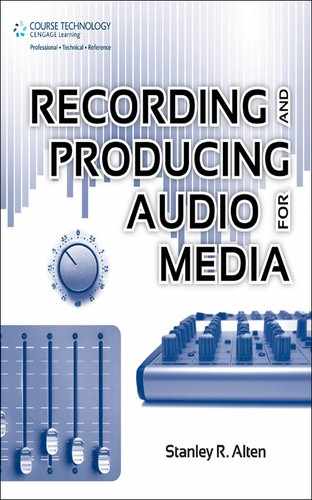0%
34Chapters
0-1Hours read
0kTotal Words
Book Description
Written by highly respected author Stan Alten, RECORDING AND PRODUCING AUDIO FOR MEDIA introduces readers to the basic techniques and principles necessary for audio production in today's media. Comprehensive, accurate, and up-to-date, the text covers informational, perceptual, and aesthetic aspects of sound as they apply to each stage of the production process, from planning to post-production. Aspiring musicians, sound engineers, and producers will also gain a fundamental understanding of the principles, technologies, and techniques of audio production and post-production for media, including radio, television, film, music recording, interactive media, the Internet, and mobile media.
Table of Contents
- Copyright
- Preface
- Acknowledgments
- I. Principles
- 1. Sound and Hearing
- 2. Acoustics and Psychoacoustics
- II. Technology
- 3. Loudspeakers and Monitoring
- 4. Microphones
- Operating Principles
- General Transducer Performance Characteristics
- Directional Characteristics
- Sound Response
- Microphone Modeler
- Special-Purpose Microphones
- Lavalier Microphones (Mini-Mics)
- Shotgun Microphones
- Parabolic Microphone System
- Headset and Earset Microphones
- Contact Microphones
- Boundary Microphones
- Noise-Canceling Microphones
- Multidirectional Microphones
- Infinitely Variable Pattern Microphones
- Binaural and Surround-Sound Microphone Systems
- High-Definition Microphones
- Digital Microphones
- USB Microphones
- Other Special-Purpose Microphones
- Wireless Microphone System
- Microphone Accessories
- Microphone Care
- Main Points
- 5. Consoles and Control Surfaces
- 6. Recording
- 7. Synchronization and Transfers
- 8. Signal Processors
- III. Production
- 9. Sound and the Speaking Voice
- 10. Voice-Overs and Narration
- 11. Dialogue
- Recording Dialogue in Multi- and Single-Camera Production
- Recording Dialogue in the Field
- How Directors Can Help the Audio Crew
- Production Recording and the Sound Editor
- Automated Dialogue Replacement
- Main Points
- 12. Studio Production: Radio and Television
- 13. Field Production: News and Sports
- 14. Sound Design
- 15. Sound Effects
- 16. Music Underscoring
- Uses of Music in a Production
- Music Characteristics
- Functions of Music Underscoring
- Music in Spot Announcements
- Creative Considerations in Underscoring
- Approaches to Underscoring
- Prerecorded Music Libraries
- Customized Music Programs
- Customized Musical Instrument Programs
- Copyright and Licenses
- Using Music from Commercial Recordings
- Using Music from Sample CDs and the Internet
- Organizing a Music Library
- Main Points
- 17. Audio for Interactive Media: Game Sound
- 18. Internet Production
- 19. Music Recording
- IV. Postproduction
- 20. Editing
- 21. Mixing: An Overview
- 22. Music Mixdown
- 23. Premixing and Rerecording for Television and Film
- 24. Evaluating the Finished Product
- A Occupations in Audio
- Selected Bibliography
- Glossary
